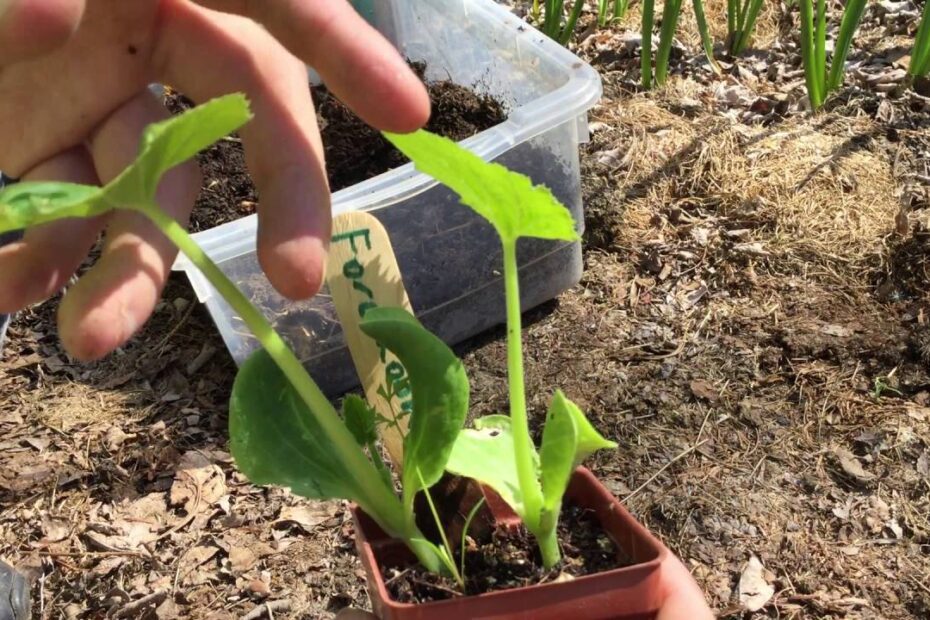In the verdant realms of vegetable gardening, where green thumbs flourish and sun-kissed leaves dance in harmony, lies a humble yet vibrant superstar: the zucchini. With an unrivaled ability to thrive in almost any garden, this bountiful plant generously offers up its magnificent fruits. Ah, but what if your garden space is limited or lacks the ideal growing conditions? Fear not, dear gardeners, for in the mystical realm of transplanting lies a secret passage to zucchini paradise! Join us as we embark on a horticultural adventure, unlocking the secrets of successful zucchini transplantation.
Preparing the Zucchini Transplantation: Ensuring Optimal Conditions for Successful Growth
When it comes to transplanting zucchini, proper preparation and optimal conditions play a vital role in ensuring successful growth. Follow these essential steps to give your zucchini plants the best head start:
1. Choose the Right Location:
Zucchinis thrive in full sun, so select a location in your garden that receives at least 6 to 8 hours of direct sunlight daily. Ensure the soil is well-draining and rich in organic matter by amending it with compost or well-rotted manure.
2. Prepare the Soil:
Before transplanting, loosen the soil in the chosen area using a fork, removing any weeds or rocks. Incorporate a balanced fertilizer into the soil to provide essential nutrients for optimal growth.
Features and Tips:
| Feature | Tip |
|---|---|
| Ample Space | Ensure you provide enough space between zucchini plants to allow for proper air circulation and prevent overcrowding. |
| Regular Watering | Zucchinis require consistent and deep watering, especially during dry periods. Keep the soil evenly moist but not waterlogged. |
| Supporting Structures | Consider using trellises or stakes to support the zucchini plants as they grow, keeping the fruits off the ground and reducing the risk of diseases. |
3. Transplant with Care:
Before transplanting your zucchini seedlings from their indoor containers or nursery pots, ensure they are adequately hardened off to avoid transplant shock. Dig a hole slightly larger than the plant’s root ball and gently place it in, ensuring the top of the root ball is level with or slightly above the soil surface. Firmly pat the soil around the plant to eliminate air pockets and water thoroughly.
4. Maintain Proper Care:
Once transplanted, provide regular care to your zucchini plants by watering, mulching, and monitoring for pests. Regularly fertilize with a balanced organic fertilizer to encourage healthy foliage and abundant fruiting.

Transplanting Zucchini Seedlings: Step-by-Step Guide for a Smooth Process
<p>
So, you've successfully started your zucchini seedlings indoors, and now it's time to give them a new home in your garden. Transplanting zucchini seedlings may sound daunting, but with the right steps and a little care, you'll have healthy and thriving plants in no time. To ensure a smooth process, follow this step-by-step guide for transplanting zucchini seedlings and give your squash a head start towards a bountiful harvest.
</p>
<p>
<h3>Preparing the Garden Bed:</h3>
<ul>
<li>Choose a sunny location in your garden with well-draining soil.</li>
<li>Amend the soil with organic matter, like compost, to improve fertility and moisture retention.</li>
<li>Ensure the soil pH is around 6.0 to 7.5, as zucchini thrives in slightly acidic to neutral conditions.</li>
</ul>
<h3>Transplanting Zucchini Seedlings:</h3>
<ol>
<li>Water the seedlings thoroughly a day before transplanting.</li>
<li>Carefully remove the seedlings from their containers, gently holding the soil around the roots to prevent damage.</li>
<li> Dig a hole in the garden bed that is slightly larger than the root ball of each seedling.</li>
<li>Place the seedling in the hole, ensuring it sits at the same depth as it was in the container.</li>
<li>Backfill the hole with soil, gently firming it around the base of the seedling to eliminate air pockets.</li>
<li>Water the transplanted seedlings well, ensuring the soil is evenly moist.</li>
</ol>
<h3>Top Tips for Successful Zucchini Transplanting:</h3>
<table>
<tr>
<th>Features</th>
<th>Tips</th>
</tr>
<tr>
<td>Support</td>
<td>Stake or provide support for your zucchini plants to prevent sprawling and keep the fruit off the ground.</td>
</tr>
<tr>
<td>Spacing</td>
<td>Plant zucchini seedlings about 2 to 3 feet apart to allow sufficient room for their vigorous growth.</td>
</tr>
<tr>
<td>Watering</td>
<td>Consistently water your zucchini plants, providing about an inch of water per week.</td>
</tr>
</table>
</p>
Caring for Transplanted Zucchini: Essential Tips to Promote Healthy Development
Once you’ve made the decision to transfer your beloved zucchini plants to a new home, it’s vital to ensure they settle into their new surroundings successfully. Transplanting zucchini can be a delicate process, but armed with a few essential tips, you can promote healthy development and a fruitful harvest. Let’s explore some handy techniques to guarantee your transplanted zucchini thrives!
The first crucial step in transplanting zucchini is finding the ideal location in your garden or vegetable bed. Zucchinis love basking in the sun, so pick an area that receives at least 6-8 hours of direct sunlight per day. Ensure the soil is well-draining and rich in organic matter, as zucchinis thrive in fertile conditions. Once you’ve identified the perfect spot, it’s time to give your zucchini the royal treatment!
Essential Care Tips for Transplanted Zucchini:
| 1. Gentle Handling | 2. Ample Watering | 3. Nutritional Boost |
|---|---|---|
| Handle your zucchini plants with utmost care during the transplanting process to avoid damaging their delicate roots. | Ensure your transplanted zucchinis receive regular and deep watering to keep the soil consistently moist, but avoid overwatering to prevent root rot. | Provide your zucchinis with a nutritional boost by adding a slow-release fertilizer or organic compost to the soil. This will ensure they receive the necessary nutrients for healthy growth. |
| 4. Mulching | 5. Pruning | 6. Pest Prevention |
| Mulch around your transplanted zucchinis to conserve moisture, suppress weed growth, and maintain a consistent soil temperature. | Regularly prune your zucchini plants by removing excess foliage and side shoots. This will encourage better air circulation and direct energy towards fruit production. | Implement pest prevention measures such as using organic insecticides or introducing beneficial insects like ladybugs to combat common pests like aphids or squash bugs. |
By following these essential tips, you’re well on your way to nurturing flourishing transplanted zucchini plants that will reward you with abundant harvests. Take care of your zucchinis diligently, and soon you’ll be savoring the flavors of fresh, homegrown produce from your own garden!


